This page goes into some hard-core science, with references. See our home page for a less technical explanation.
A brief survey of the scientific literature
If your body is even the slightest bit cold, it needs to burn calories to stay warm. This is an almost trivial scientific fact, backed by decades of research, all of it independent of The Cold Shoulder LLC. To quote from just a few scientific papers on the subject (there are hundreds):
In the 1960s, experiments on rats demonstrated that repeated exposure to cold would increases the rat’s ability to generate heat even at rest (ie., neither exercising nor shivering):
“In cold-acclimated rats the scope for activity was greatly extended by the acquisition of nonshivering thermogenesis. The peak rate in resting rats was increased to 420 Cal/body weight, which is nearly double the maximal level for warm-acclimated rats…” Hart & Jansky, “Thermogenesis due to exercise and cold in warm- and cold-acclimated rats”. Canadian Journal of Biochemistry and Physiology, Volume 41 (1963).
The specific tissue that is involved in “nonshiving thermogenesis” (NST for short) is called Brown Fat, or technically Brown Adipose Tissue (BAT), which was known in 1964:
“Brown adipose tissue has been shown to be a strongly thermogenic effector organ in homeothermic animals exposed to cold and in hibernators during cold-induced arousal from deep hibernation. This
cold-induced thermogenic response protects the animal by contributing heat to the vital organs.” - Robert Smith, “Thermoregulatory and Adaptive Behavior of Brown Adipose Tissue”, Science, vol 146 no 3652, pp. 1686-1689 (1964).
In the 1970s, the US Army noticed that when they sent their soldier on maneuvers in cold regions like Alaska, the soldiers came back more buff, and with less fat. In 1979 they conducted a controlled study and found that even mild exercise (walking) in cold weather could cause up to 2.3 kilos (about 5 pounds) of white fat to be burned in one week:
“One week of 2.5 hours/day of mild exercise with cold exposure led to a loss of body fat of between 0.8 and 2.3 kg. No significant changes in body composition occurred with comparable exercise under temperate conditions.” - W. J. O’hara, C. Allen, R. J. Shephard, and G. Allen. “Fat loss in the cold — a controlled study.” Journal of Applied Physiology: Respiratory, Environmental, and Exercise Physiology 45(5): 872-877 (1979).
By 2007 scientists had started to clue in to the fact that perhaps mild cold exposure could be used to counteract obesity, and pointed out that attempts to find drugs to artificially mimic the effect of cold have failed:
“Adult humans possess active brown adipose tissue that has the potential to combat obesity. Pharmaceutical agents intended to combat obesity by stimulating brown adipose tissue have now generally been discarded as candidates for human therapy.” - Jan Nedergaard et al., “Unexpected evidence for active brown adipose tissue in adult humans”, American Journal of Physiology and Endocrinology Metabolism vol 293 (2007).
In 2009 it was shown that mild cold exposure is useful for weight loss because it does not result in compensating hunger:
“According to the adipostat hypothesis for body-weight control, alterations in body weight should always be compensated by adequate alterations in food intake. Thus, increased thermogenesis should not be able to counteract obesity because food intake would be increased. Evidence is presented here that [this is not the case]: thermogenesis may counteract obesity, and is not always fully compensated by increased food intake.” - Cannon & Nedergaard, “Thermogenesis challenges the adipostat hypothesis for body-weight control”, Proceedings of the Nutritional Society, vol 268 (2009).
In 2012, Harvard scientists at the Jocelin Diabetes Clinic in Boston demonstrated that at a safe dosage level, drugs that stimulate the metabolism are not as effective as simple cold exposure when it comes
to burning extra calories:
“At doses leading to broad activation of the sympathetic nervous system, ephedrine does not stimulate BAT in humans. In contrast, mild cold exposure stimulates BAT energy expenditure with fewer systemic effects.” - Aaron Cypess et al., “Cold but not sympathomimetics activates human brown adipose tissue in vivo”, Proceedings of the National Academy of Sciences vol 109 no 25 (2012).
By 2013, scientists were starting to seriously consider mild cold as a way to treat obesity, and that it’s not as uncomfortable as one might first think. Here’s a quote from scientists in the Netherlands:
“In recent years, it has been shown that humans have active brown adipose tissue (BAT) depots, raising the question of whether activation and recruitment of BAT can be a target to counterbalance the current obesity pandemic. Here, we show that a 10-day cold acclimation protocol in humans increases BAT activity in parallel with an increase in nonshivering thermogenesis (NST). No gender differences in BAT presence and activity were found either before or after cold acclimation. The observed physiological acclimation is in line with the subjective changes in temperature sensation; upon cold acclimation, the subjects judged the environment warmer, felt more comfortable in the cold, and reported less shivering. The combined results suggest that a variable indoor environment with frequent cold exposures might be an acceptable and economic manner to increase energy expenditure and may contribute to counteracting the current obesity epidemic.” — Anouk van der Lans et al., “Cold acclimation recruits human brown fat and increases nonshivering thermogenesis”, Journal of Clinical Investigation vol 123 no 8 (2013).
In the very same issue of the same journal, Japanese scientists found explicitly that mild cold exposure for 2 hours per day for 6 weeks produced significant reductions in body fat, and that BAT isn’t even necessary for the process:
“Brown adipose tissue (BAT) burns fat to produce heat when the body is exposed to cold and plays a role in energy metabolism. Thus, the recruitment of BAT may be effective for body fat reduction. Acute cold exposure at 19°C for 2 hours increased energy expenditure (EE) and cold-induced thermogenesis (CIT). Cold-induced increments of EE (CIT) strongly correlated with BAT activity independently of age and fat-free mass. Daily 2-hour cold exposure at 17°C for 6 weeks resulted in a parallel increase in BAT activity and CIT and a concomitant decrease in body fat mass. Changes in BAT activity and body fat mass were negatively correlated. These results demonstrate that human BAT can be recruited even in individuals with decreased BAT activity, thereby contributing to body fat reduction.” — Takeshi Yoneshiro et al., “Recruited brown adipose tissue as an antiobesity agent in humans”, Journal of Clinical Investigation vol 123 no 8 (2013).
Finally, in 2014, the subject of weight loss induced by cold exposure became so popular in the scientific community that a review article was published summarizing the evidence, along with a press release talking about the article:
“Obesity is a consequence of positive energy balance, which can be counterbalanced by eating less, increasing physical activity, or pharmacological approaches. However, weight maintenance is generally disappointing, and long-term use of pharmaceuticals has been limited because of lack of efficacy, poor long-term adherence rates, and serious adverse effects. These limitations indicate that, given our current knowledge and available technologies, insights from other fields of research will be necessary to permit exploration of new ideas and develop effective applications. We suggest that regular exposure to mild cold may provide a healthy and sustainable alternative strategy for increasing energy expenditure.” — Lichtenbelt et al., “Cold exposure - an approach to increasing energy expenditure in humans”, Cell Press: Trends in Endocrinology and Metabolism, Vol 25 no 4 (April 2014).
My own clinical trials of The Cold Shoulder suggest that when used twice a day taken directly from the freezer and worn until the ice melts, results in accelerated fat loss at the rate of about one pound a week, corresponding to about 500 calories burned per day.
The Cold Shoulder is also undergoing patent examination, under non-provisional utility patent # 14/281,666..
 Further reading - articles and authors are all independent of The Cold Shoulder
Further reading - articles and authors are all independent of The Cold Shoulder
Articles (for a general audience)
What is BAT? Researchers at the University of Texas explain the origin and function of fat-burning fat, aka Brown Fat, aka Brown Adipose Tissue (BAT): http://www.sciencedaily.com/releases/2013/09/130926102259.htm?utm_source=feedburner&utm_medium=email&utm_campaign=Feed%3A+sciencedaily%2Fhealth_medicine%2Fdiet_and_weight_loss+(ScienceDaily%3A+Health+%26+Medicine+News+-+Diet+and+Weight+Loss)
BAT’s where it’s at! Researchers at the Harvard Medical School discover why cold exposure is better than currently available drugs to activate BAT for weight loss.: http://www.sciencedaily.com/releases/2012/06/120604155556.htm
BAT, insulin, cold exposure, and Diabetes: From the Joslin Center for Diabetes (part of the Harvard Medical School), an article on the location of BAT, burning calories through cold exposure, and its relation to treatment of Diabetes: http://www.joslin.org/diabetes-research/turning-up-the-heat-on-brown-fat.html
Deep Chill: An article from WIRED magazine details some recent experiments by pioneer cold-exposure guru Ray Cronise: http://www.wired.co.uk/magazine/archive/2013/04/features/the-shiver-system
Trading one furnace for another: Men’s Journal recommends turning down your thermostat in order to lose weight: http://www.mensjournal.com/health-fitness/health/to-lose-weight-just-turn-down-the-thermostat-20130808
Cold Paleo: Cold therapy for Paleo Diet enthusiasts:: http://paleodietlifestyle.com/cold-water-therapy/
Lose Weight Naturally: An article on natural weight loss via cold therapy, from Natural News: http://www.naturalnews.com/038089_brown_adipose_tissue_fat_burning_body_weight.html
Two articles on how cold exposure can aid sleep:
http://www.scientificamerican.com/article.cfm?id=putting-insomnia-on-ice
http://valleysleepcenter.com/blog/coldshower/
BAT for Dummies: The Get Fit Guy on Quick and Dirty Tips explains cold exposure and weight loss: http://www.quickanddirtytips.com/health-fitness/exercise/how-use-cold-weather-lose-weight?page=all
From across the pond: The UK newspaper The Telegraph publishes an article on cold exposure and weight loss: http://www.telegraph.co.uk/health/healthnews/8320317/A-dose-of-the-cold-could-help-weight-loss-and-reduce-heart-disease.html
Videos
Thermal Dieting: Tim Ferriss, author of the New York Times Bestseller The Four Hour Body, explains “Thermal dieting”, another term for cold-exposure induced weight loss: http://www.youtube.com/watch?v=xvOBQOHZR2E
DrAshburn.com: Dr. Eric Ashburn explains cold exposure and weight loss while discussing Ray Cronise, swimming, and Tim Ferriss’s Four Hour Body: http://www.youtube.com/watch?v=kGptmntC-mE
Ray Cronise at TED MED: http://www.youtube.com/watch?v=UrQ_ldCwKUQ
Books
Tim Ferriss’s book The Four Hour Body: http://fourhourbody.com/
 Selected Scientific References
Selected Scientific References
Here is a non-exaustive list of academic articles on BAT, cold exposure, weight loss, obesity, diebetes, etc. Most of these articles are rather technical in nature; proceed at your own risk. Furthermore, although the abstracts should all be readable, in some cases the full article may require a paid subscription (or one-time payment) to read.
Articles are listed in no particular order.
A very recent review article in CELL, the single most prestegious biology journal in the world:
http://www.cell.com/trends/endocrinology-metabolism/pdf/S1043-2760%2814%2900010-1.pdf
A 2011 article on how obesity can be treated using cold exposure: http://www.cell.com/trends/molecular-medicine/abstract/S1471-4914(11)00067-0
A nice review article: Ravussin E, Kozak LP. “Have we entered the brown adipose tissue renaissance?” Obesity Reviews. 2009 May;10(3):265-8. doi: 10.1111/j.1467-789X.2008.00559.x. Epub 2009 Jan 19. (http://www.ncbi.nlm.nih.gov/pubmed/19175509)
Cold exposure treats depression: Rymaszewska J, Ramsey D, Chladzinska-Kiejna S. “Whole-body cryotherapy as adjunct treatment of depressive and anxiety disorders.” Arch Immunol Ther Exp (Warsz). 2008 Jan-Feb;56(1):63-8. doi: 10.1007/s00005-008-0006-5. Epub 2008 Feb 5. (http://www.ncbi.nlm.nih.gov/pubmed/18250970 )
More on cold exposure treating depression: Shevchuk NA. “Adapted cold shower as a potential treatment for depression.” Med Hypotheses. 2008;70(5):995-1001. Epub 2007 Nov 13. (http://www.ncbi.nlm.nih.gov/pubmed/17993252)
Cold exposure boosts the immune system: Jansky L, Pospísilová D, Honzová S, Ulicny B, Srámek P, Zeman V, Kamínková J. “Immune system of cold-exposed and cold-adapted humans.” Eur J Appl Physiol Occup Physiol. 1996;72(5-6):445-50. (http://www.ncbi.nlm.nih.gov/pubmed/8925815)
Two articles about cold exposure increasing adiponectin levels (as long as you don’t eat carbs). Note that adiponectic can aid lean muscle gain; this mechanism is still not well understood, but suggests that cold exposure may lead to increased muscle gain. Ray Cronise certainly noticed it, as explained by Tim Ferriss in the Four Hour Body:
Imbeault P, Dépault I, Haman F. “Cold exposure increases adiponectin levels in men.” Metabolism. 2009 Apr;58(4):552-9. doi: 10.1016/j.metabol.2008.11.017. (http://www.ncbi.nlm.nih.gov/pubmed/19303978)
Takayuki Masaki, Seiichi Chiba, Tohru Yasuda, Tetsuo Tsubone, Tetsuya Kakuma, Iichiro Shimomura, Tohru Funahashi, Yuji Matsuzawa and Hironobu Yoshimatsu. “Peripheral, But Not Central, Administration of Adiponectin Reduces Visceral Adiposity and Upregulates the Expression of Uncoupling Protein in Agouti Yellow (Ay/a) Obese Mice” Diabetes September 2003 vol. 52 no. 9 2266-2273. doi: 10.2337/diabetes.52.9.2266 (http://diabetes.diabetesjournals.org/content/52/9/2266.long)

